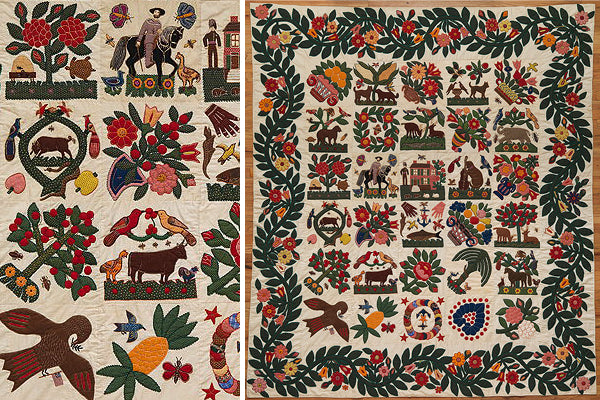by guest blogger Robert Shaw, an American quilt expert, author and dealer.
SHELBURNE VT The subtitle of my recently updated book on American quilts is The Democratic Art. I am not talking about politics here, but “small d” democracy.
To my mind, quiltmaking is a quintessentially democratic art, available to almost everyone. Anyone with basic sewing skills can create a quilt. (A fact that leaves me out, since I can barely sew a button on a shirt, but I am the exception that proves the rule.) And every kind of person, in every state in the union, has made quilts.
The amazing thing is that all this diversity is tied together by a single thread—the universal human desire for self-expression. There is a lot of emphasis in quilt circles these days on technique, but what I think matters most is not how technically skilled a quilt’s maker is, but how much of herself she put into her work—how personal, inventive, original, imaginative, and authentic her creation is.
For me, those are the qualities that lift a quilt (or any other work for that matter) from craft to art, that distinguish it from others of its kind and make it stand out among the hundreds of thousands of quilts that have been made in this country over the past 250 years.
Let me explain what I mean by talking about a few of my favorite quilts in the book:
This is a full-sized quilt made by Nancy Ward Butler of Jamestown, New York to commemorate the passing of her granddaughter, Nancy A. Butler, who was 20 months old when she died on February 3, 1842. I am moved by how bold and direct this blue and white quilt is, and by Mrs. Butler’s use of capital letters that run on from line to line, making the quilt’s message at once more graphic and more abstract. Collection of the National Museum of American History, Washington, DC
This Cotton Boll was made around 1860 by Mary Francis Donohue of Cherry Hill, North Carolina, just before the start of the Civil War and her state’s secession from the Union. Other Southern women worked this pattern, but this bold version is distinguished by its starkly powerful use of red and its Flying Goose Chase outer border and sashing, which is punctuated with small applique blocks of single budded roses. And I love that the rose at bottom left is turned in a different direction from all the others. Collection of the North Carolina Museum of History
This decidedly different Baltimore album quilt top comes under the heading of who knew? It is one of a small group of Baltimore albums that have recently been tied to Jewish families in the city, which had a significant Jewish population in the mid–nineteenth century, when this and other albums were made. What it lacks in refinement in comparison to classic Baltimore albums, many of which were designed or made by professional seamstresses, it more than makes up for in its rich mix of plant, bird and animal imagery and its bold, chunky vine and flower border. Jane Katcher Collection of Americana
Ellen Harding Baker of Cedar County, Iowa made this quilt to illustrate lectures she gave about her hobby, astronomy. The comet entering the solar system at the upper left is undboutedly Halley’s, which circles the sun in an elliptical obit that brings it into human view every 75 or 76 years.
Halley’s Comet is the only comet readily seen by the naked human eye and has been observed for thousands of years. This quilt always makes me think of Mark Twain, who was born two weeks after Halley's Comet appeared in November 1835, and predicted in his autobiography that he would "go out with it" too. Sure enough, he died the day after the comet's return in April 1910. Collection of the National Museum of American History, Washington, DC
As its imagery suggests, this privately owned quilt was made by a Native American woman. She was a Lakota Sioux from South Dakota whose name was Rebecca Blackhorse or Blackwater. Her applique design, which she made around 1900, is an adaptation of a traditional “winter count,” an annual rendering of events that had taken place in a community over the course of a year. There are scenes of hunting, wild and domestic animals, travel, children at play, and women cooking. The two beasts that look like kangaroos actually represent the mythical Great Bear, the creator of the earth. Notice that the bird’s nest in the upper left corner has two eggs in it, while the one at bottom right has two hatchlings.
The different shapes, sizes, colors, and directions of the appliques dance against the solid black background and tell a complex story that mixes the rituals and rhythms of daily life with symbolism and mystery.
Here’s a quirky quilt top that could have been in Roderick Kiracofe’s new book Unconventional and Unexpected. This beauty was made about 1960 and found in Chapel Hill, North Carolina by Marjorie Childress, who contributed several other great pieces to Roderick’s book. It’s made up of hexagons that the unknown maker created by combining two triangles and one or two central squares or rectangles. The slightly different shapes of the pieces and the brilliantly intuitive color arrangements make it impossible for the viewer’s eye to stand still. To my own roving eye, the light and dark play of blues and white combined with black and red suggest dappled sunlight on moving water.
Finally, here’s a quilt by a man, the late Jeff Gutcheon, who was a pioneer in bringing modern design concepts to traditional quiltmaking. This is titled Crystal Mountain and was made in 1978. Jeff was a polymath who had careers in architecture and music as well as quiltmaking and fabric design.
The quilt employs Diamond Patchwork, a technique Jeff invented that places flat patterns on a matrix that appears to be three-dimensional. The trompe l’oeil spatial illusion in this piece is quite an eye bender, with its craggy architectural left side set off by the large negative white space on the right, which can be read as fields of snow. Jeff told me that when he first showed this around, people told him they liked the left side but asked him when he was going to finish the rest of the quilt. The Crystal Mountain was the site of a Tibetan monastery featured in Peter Matthiessen’s magical book The Snow Leopard. Jeff’s “Crystal Mountain” was donated to the Shelburne Museum a couple of years ago in his honor.
All seven of these quilts fit my criterion of personal, inventive, original, imaginative, and authentic. And there are nearly 350 more in the book!
Shown in post header: Detail of The Prosperity Quilt: “Prosperity Is Just Around The Corner” by Fannie B. Shaw, 1930-32 Dallas Museum of Art
To visit Robert’s website, The Art of the Quilt +click here.
















